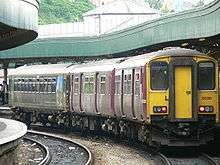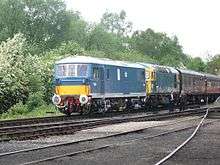Multiple working

Multiple working is a term used on the UK rail network to describe the practice of having more than one diesel or electric locomotive hauling a train under the control of one driver (multiple-unit train control).
Terminology
| “ | Many main-line diesel-electric and hydraulic locomotives are capable of running in multiples of up to three under the control of one driver | ” | |
| — British Railways Diesel Traction Manual for Enginemen, [1] | |||
Multiple Working is the term used in the UK where more than one operational diesel or electric locomotive are coupled together under the control of one driver. The term can also apply when diesel or electric multiple unit trains are coupled together and also under the control of one driver. 'In tandem' is the term usually used in the UK when more than one diesel or electric locomotive are hauling a single train and under the control of a driver on each locomotive.
If the front locomotive of a pair in multiple has failed the driver can still control the rear locomotive for as long as air and electricity supplies are available on the failed locomotive.
Locomotives
In the early days of diesel locomotives, locomotives worked within their class (i.e. two locomotives of the same class could work together but not with other classes). Locomotives from different manufacturers had varying methods of controlling engines or braking systems. If a train required more than one locomotive, an additional driver was needed, at extra expense.
Since then, locomotives have been built to work with other locomotives in the same code or system. Similar systems are assigned a coupling code, which is normally indicated on the front of the locomotive.
Early diesels were also fitted with communicating doors in the nose which allowed the secondman to access the train heating boiler of the rearmost locomotive. The doors actually saw little use and, as they frequently caused draughts in the cab, many of them were later welded shut.
| Coupling code | System | Class of locomotives |
|---|---|---|
| Electro-pneumatic | Class 15, Class 17 (Nos D8588–8616), Class 20, Class 21 (Nos D6138-6157), Class 24, Class 25, Class 26, Class 27, Class 31/1, Class 33, Class 37, Class 40, Class 44, Class 45 and Class 46, Class 73 (under diesel power only). | |
| ● Red Circle | Electro-magnetic | Class 16, Class 21 (Nos D6100- 6137), Class 28, Class 29, Class 31/0. |
| ● Green Circle | Some Class 47. | |
| ■ Orange Square | Diesel hydraulic - 1st use | Class 22 (D6300 - 6305), D600 Warship |
| Symbol re-used for different system | Class 50 | |
| Class D16/1 (nos 10000/10001) Class 17 (D8500–D8587) | ||
| Symbol re-used for different system | Class 56, Class 58 | |
| Diesel hydraulic | Class 22 (D6306 - 6357), Class 42, Class 43 | |
| Diesel hydraulic | Class 35 | |
| SR EMU System | Class 33/1, Class 73, Mark One Electric Multiple Units, Class 442. | |
| AC electric locomotives | Class 87, some Class 86s. | |
| Within own class only | Class 43 (InterCity 125) Class 60. | |
| TDM System | Class 86, Class 87, Class 89, Class 90, Class 91, DBSO, DVT. | |
| AAR System [2] | Class 59, Class 66, Class 67 & Class 70, plus several converted DVTs | |
Multiple units
First-generation

First-generation diesel multiple units had the additional problem of differing types of transmission. For instance, a Class 127 unit (hydraulic transmission) could be required to work in multiple with a Class 112 unit (mechanical transmission). For this reason, the drive selector on the Class 127 was fitted with positions marked "D, 3, 2, 1" to change the gears when working in formation with vehicles with mechanical transmission.[3]
First-generation DMU coupling codes:
| Coupling code | Class |
|---|---|
| ■ Blue Square | Most units with mechanical transmission |
| |
Most units with hydraulic transmission |
| |
Derby Lightweight (mechanical transmission) |
| Derby Lightweight (hydraulic transmission) | |
| O White Circle | Class 126 |
Second-generation
Most second-generation units built by British Rail were designed to use the BSI multiple working system, including members of the 14x Pacer and 15x Sprinter families. Later units, post-privatisation ones in particular, saw a number of different, incompatible systems re-emerge. Examples include the Dellner-coupled Class 220, 221 and 390, originally used by Virgin Trains, and the Scharfenberg-coupled Class 175 and 180, originally used by First North Western and First Great Western respectively. Franchise changes and stock reallocation means that many train operating companies use fleets with a number of incompatible multiple working systems.
References and sources
References
- ↑ British Railways Diesel Traction Manual for Enginemen. British Transport Commission. 1962. p. 184.
- ↑ US Loco MU Control
- ↑ The Railcar Association. "Description of the Class 127s". Retrieved 2007-08-22.
Sources
- Williams, Alan; Percival, David (1977). British Railways Locomotives and Multiple Units including Preserved Locomotives 1977. Shepperton: Ian Allan. ISBN 0-7110-0751-9.
